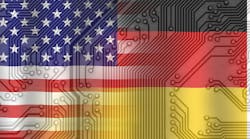Germany and the US: A Transatlantic Race to Digital Manufacturing
With some of the most advanced manufacturing industries in the world, the U.S. and Germany in particular stand to gain much from the new ‘digital manufacturing era’ or Industry 4.0 – that is, the integrated application of computer technology to all phases of the production process. Certainly, technological advancements are creating huge opportunities for individual manufacturers to improve the quality of production while streamlining internal efficiencies and reducing overheads.
Yet a number of crucial challenges remain to realizing the full benefits of digital manufacturing. Firstly, manufacturers must identify and invest in the “right” technology – that will increase production capacity and flexibility, all the while delivering a clear business case. At the same time, the required investment must be funded while maintaining reasonable levels of capital expenditure and liquidity.
Specialist financiers can help overcome such challenges; guiding manufacturers through new technology and providing bespoke, yet flexible, financing solutions. And by using smart financing techniques – such as tying payments to the performance or longevity of the underlying technology – manufacturers can be more confident in the cost and value of their investment.
Why Join the Race?
At a macroeconomic level, digitalizing the manufacturing process means that more products can be produced closer to the customer base, thus reducing the need to import from abroad. Boston Consulting Group, for instance, predicts that as much as 30% of America's imports from China could be produced domestically by 2020 as a result of Industry 4.0. Given the U.S. trade deficit hit a record $367 billion last year, cutting transportation costs would be a huge benefit.
But what about the individual companies that will shoulder the burden of implementing new technology?
First and foremost, Industry 4.0 stands to boost product quality. Innovative technology such as robotics, for instance, can improve maintenance and fault diagnostics for products such as cars, giving manufacturers a competitive edge in the market.
At the same time, new technologies are boosting productivity and efficiency. For instance, so-called ‘digital twin’ technology, which uses a computerized copy of a real product, means that manufacturers can conduct performance tests digitally and save on material wastage. This cuts costs and improves product development time – which enhances speed to market.
What is more, as the U.S. shows, it is not just high-tech sectors that stand to benefit from advanced manufacturing processes, but also a range of industries: from energy and aircraft, to healthcare, and food.
Yet, while both the U.S. and Germany have made huge strides forward in their digitalization journey, each country is taking different steps to approaching Industry 4.0.
The U.S., for its part, is taking a revolutionary approach, with rapid changes in the country’s manufacturing industry being driven by the world’s densest hub of innovative start-up companies in Silicon Valley. The German approach, on the other hand, is more evolutionary, with the country’s strong industrial base incrementally improving and refining existing technology and processes through increased digitalization.
The Challenge: Funding the “Right” Technology
Despite different approaches, challenges remain for all. If manufacturers are to fully adapt their production lines to Industry 4.0 and keep up-to-date with new technologies, they must source significant investment. In Germany alone, an additional €250 billion (or $284 billion) will be needed over the next 10 years. This represents about 1% to 1.5% of manufacturers’ total revenues.
The story is similar in the U.S. In order to modernize its factories, American multinational corporation General Motors (GM), for instance, is planning to invest $1.8 billion (€1.6 billion) every year over the next three years: were all U.S. manufacturers to make an equivalent investment, the total expenditure would amount to around $100 billion (€88 billion) a year.
That said, capital outlays only make business sense if they invested in the “right technology”. Manufacturers, rightly, are often concerned that technology is advancing at such a rate that technology will become obsolete before they can profit from it – rendering their investment redundant.
Overcoming the Challenges with Innovative Financing
So how can these key challenges be overcome? Crucially, manufacturers need access to tailored, well-structured financing that is innovative and flexible enough to cope with the ever-evolving technological environment.
This finance usually resembles traditional ‘asset finance’ – and, more often than not, a variation of leasing or renting. First and foremost, this type of financing can remove the need for an initial capital outlay – as discussed, a key barrier for many manufacturers looking to implement digital solutions. Take the example of Friedrich A. Kruse jun. International Logistics, a German logistics company which was keen to modernize its facilities by switching to Siemens control and drive technology. In this instance, Siemens Financial Services provided a leasing solution which protected the company’s liquidity – by removing the need for a purchase – while the long-term nature of the contract allowed the company to finance the installments from operating cash-flow.
There are also a number of financing solutions that can overcome the second key challenge; ensuring investment in the “right” technology. Our view is that manufacturers should start by setting out what they want to achieve in their concrete business case – whether it be increased productivity, better quality products for clients etc. – and then work backwards to decide how the necessary investments can be funded. The structuring of such solutions is, of course, helped by working alongside a financier that has detailed knowledge of the technologies involved, how they are applied, and the operating, capability or efficiency outcomes that they will likely deliver.
This approach opens up a number of innovative financing solutions. “Performance-based financing”, for one, allows to provide contracts which match payments to defined and measurable business benefits.
Another option in this respect is “usage-based financing”, such as pay-per-use programs for equipment investments. Again, the manufacturer benefits from not having to splash out on new technology at day one, instead paying as per its usage – ensuring that it receives value from any expenditure. Such a solution also provides manufacturers with the flexibility to upgrade machinery or switch to next-generation technology as and when it becomes available and attractive.
Of course, the cost of purchase is only one cost element associated with investing in new machinery; there are also costs relating to service, software and maintenance. “Total cost of ownership” financing therefore accounts for the full cost of digital technology, providing a financially reliable package that ensures running costs will not escalate unpredictably over the technology’s lifetime. This approach works well to highlight when it makes more financial sense to upgrade technology rather than continue with an older system.
Financing packages such as these are crucial if manufacturers are to overcome the challenges associated with implementing new technology, and thus seize the opportunities with respect to increased productivity, efficiency and quality of product. They will also play a significant role in helping Germany and the U.S. over the line in the transatlantic race to digital manufacturing.
Roland Chalons-Browne is CEO of Siemens Financial Services, an international provider of business-to-business financial solutions with more than 3,000 employees worldwide. Drawing on his decades of experience in the financial-services sector, Chalons-Browne leads the global activities of Siemens Financial Services, which involves leveraging his specialist financing expertise in the energy, healthcare, industry, and infrastructure and cities markets.





